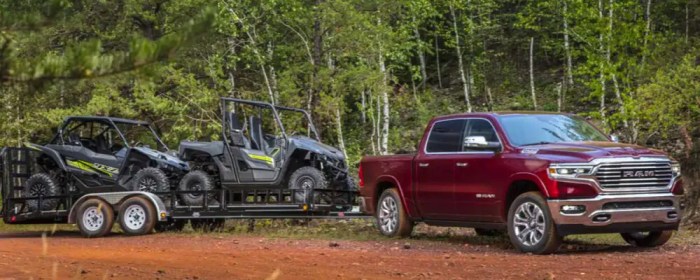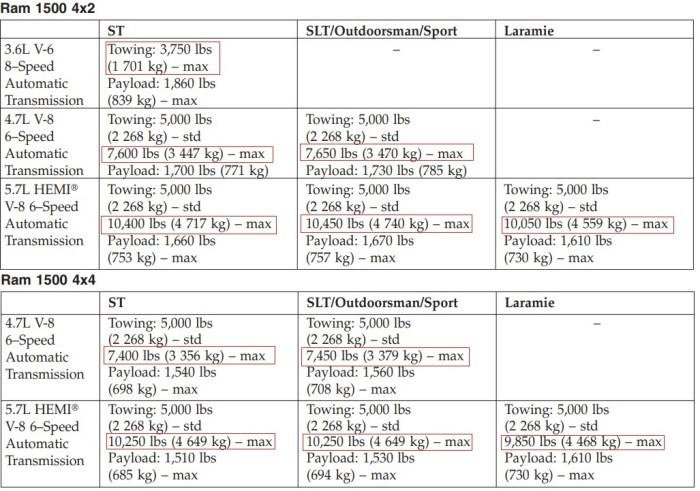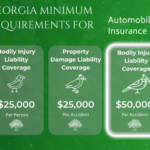How to increase towing capacity on a RAM 1500? That’s a question a lot of truck owners ask, especially when they need to haul bigger loads or heavier trailers. This isn’t just about throwing on some extra parts; it’s about understanding your truck’s limits, making smart upgrades, and towing safely. We’ll cover everything from weight distribution hitches to upgrading your brakes, so you can confidently tow more without compromising safety.
We’ll break down the factory specs for different RAM 1500 models, explain the factors that affect towing capacity (like engine size and axle ratio), and walk you through the process of upgrading your truck to handle heavier loads. We’ll also touch on important safety considerations, legal limits, and proper towing techniques. Get ready to maximize your RAM 1500’s towing potential!
Understanding RAM 1500 Towing Capacity Limits
Knowing your RAM 1500’s towing capacity is crucial for safe and legal operation. Exceeding this limit can lead to serious consequences, from damage to your truck and trailer to accidents. This section will clarify the factors that determine your truck’s towing capabilities and the risks associated with exceeding them.
RAM 1500 Towing Capacity by Model and Trim
The maximum towing capacity of a RAM 1500 varies significantly depending on the model year, engine, transmission, and optional packages. It’s important to consult your owner’s manual for the precise specifications of your specific truck. The following table provides a general overview, but it’s not exhaustive and shouldn’t be used as a definitive guide. Always check your owner’s manual or the official RAM website for the most accurate information.
| Model Year | Trim Level | Max Towing Capacity (lbs) | Notes |
|---|---|---|---|
| 2023 | Tradesman | 7,700-10,000 | Varies based on engine and optional packages |
| 2023 | Big Horn/Lone Star | 7,700-12,750 | Varies based on engine and optional packages |
| 2023 | Rebel | 10,000-12,750 | Varies based on engine and optional packages |
| 2023 | Limited | 7,700-12,750 | Varies based on engine and optional packages |
Factors Influencing Towing Capacity
Several key factors determine the towing capacity of your RAM 1500. Understanding these factors is essential for choosing the right truck for your towing needs and avoiding overloading.
Engine Size: Larger engines generally provide more power and torque, leading to higher towing capacities. For example, a RAM 1500 with a Hemi V8 will typically have a higher towing capacity than one with a V6 engine.
Transmission: The transmission plays a crucial role in transferring engine power to the wheels. Heavier-duty transmissions, designed to handle higher torque loads, are necessary for increased towing capacity.
Axle Ratio: A higher axle ratio (e.g., 3.92 or 4.10) allows for greater pulling power at lower engine speeds, enhancing towing performance. Lower axle ratios (e.g., 3.21) are geared more towards fuel efficiency.
Payload Package: This optional package often includes heavy-duty suspension components, upgraded brakes, and other reinforcements designed to increase the truck’s payload and towing capacity. Without this package, the truck’s structural integrity may be compromised under heavy loads.
So you’re trying to boost your RAM 1500’s towing power? Upgrading the suspension and tires is a good start, but if you’re hauling some serious weight, you might need something more substantial. Check out this list of Best diesel trucks for towing 2025 to see what serious towing capacity looks like. Ultimately, though, for your RAM 1500, consider a weight distribution hitch; that’ll make a real difference.
Consequences of Exceeding Towing Capacity
Overloading your RAM 1500 by exceeding its towing capacity can have serious and potentially dangerous consequences. These include:
Reduced Braking Performance: A heavier load requires significantly more braking power. Overloaded brakes may not be able to stop the vehicle effectively, increasing the risk of accidents.
Increased Tire Wear: Excessive weight puts extra strain on tires, leading to premature wear and potential tire failure.
Suspension Damage: Overloading can damage or break suspension components, leading to poor handling and potentially dangerous situations.
Transmission and Engine Problems: The constant strain of towing excessive weight can damage the transmission and engine, resulting in costly repairs.
Reduced Fuel Economy: Towing a heavier load significantly reduces fuel efficiency.
Voiding Warranty: Exceeding the manufacturer’s recommended towing capacity can void your vehicle’s warranty.
Legal Ramifications: In some jurisdictions, exceeding towing capacity is illegal and can result in fines or other penalties.
Weight Distribution and Hitch Systems: How To Increase Towing Capacity On A RAM 1500
Upgrading your RAM 1500’s towing capacity often involves more than just a stronger hitch; it necessitates understanding and utilizing weight distribution hitches. These systems dramatically improve towing stability and control, especially when hauling heavier loads. They prevent sway, reduce stress on your truck’s suspension, and enhance overall safety.Weight distribution hitches work by transferring a portion of the trailer’s tongue weight from the rear of your truck to the front axle, creating a more balanced weight distribution across all axles.
This prevents the rear of your truck from sagging and improves handling, especially during turns and in windy conditions.
Weight Distribution Hitch Components and Function
A typical weight distribution hitch consists of several key components working in concert. Imagine a system of interconnected levers and springs. First, there’s the hitch ball mount, which attaches to the receiver hitch on your RAM 1500. Connected to the ball mount are two bars, often called “shank” or “arms”, which extend back to the trailer. These bars connect to spring bars (or sometimes chains) that run to the trailer’s tongue.
These spring bars are crucial; they provide the weight distributing force. Finally, sway control is usually incorporated, often through chains or friction devices connected between the shank and the trailer. These chains or friction devices prevent side-to-side movement (sway) of the trailer. The entire system works together to balance the weight and stabilize the trailer during towing. A diagram would show the hitch ball, the shank extending back, the spring bars connecting to the trailer tongue, and the sway control mechanism connecting the shank and trailer.
Types of Weight Distribution Hitches
Choosing the right weight distribution hitch depends on your specific towing needs and the weight of your trailer. Several types exist, each with its own advantages and disadvantages.
- Friction Weight Distribution Hitches: These hitches use friction between the spring bars and the hitch head to distribute weight. They’re generally less expensive but may not provide as much weight distribution as other types.
- Pros: Relatively inexpensive, easy to install.
- Cons: May not provide sufficient weight distribution for heavier trailers, can wear down quicker than other systems.
- Sway Control Weight Distribution Hitches: These hitches combine weight distribution with sway control mechanisms, usually chains or friction devices that limit lateral movement. This is often the most popular and recommended type for larger trailers.
- Pros: Excellent weight distribution and sway control, improved safety and handling.
- Cons: More expensive than friction-only hitches, require more precise adjustment.
- Ball Mount: While not strictly a weight distribution hitch itself, the ball mount is a crucial component. It’s the part of the hitch that the trailer ball couples to. Choosing the correct ball mount height is critical for proper weight distribution.
- Pros: Essential for connecting the trailer to the hitch.
- Cons: Improper height can negate the benefits of a weight distribution hitch.
Installing a Weight Distribution Hitch on a RAM 1500
Installing a weight distribution hitch requires careful attention to detail and proper adjustment. Incorrect installation can compromise safety and negate the benefits of the system.
- Gather your tools and equipment: This includes the weight distribution hitch, ball mount (with appropriate rise/drop for your trailer and truck), hitch pin, gloves, and a torque wrench.
- Secure the ball mount: Insert the ball mount into your RAM 1500’s receiver hitch and secure it with the hitch pin. Ensure the ball mount is properly seated and the pin is firmly in place.
- Attach the spring bars: Connect the spring bars to the ball mount and the trailer’s tongue. Follow the manufacturer’s instructions for proper connection.
- Connect the sway control: If your hitch has sway control, connect the chains or friction devices according to the manufacturer’s instructions. These usually attach to both the hitch shank and the trailer.
- Adjust the tension: This is crucial. Too much tension can damage your truck or trailer; too little will negate the benefits of the weight distribution system. Consult your hitch’s instructions for proper adjustment procedures. This often involves tightening or loosening the spring bars to achieve the correct level of weight transfer.
- Test the setup: Before towing, perform a test run in an empty parking lot to ensure the hitch is working correctly and the trailer is stable.
Upgrading Components for Increased Towing
Upgrading your RAM 1500 for increased towing capacity involves strategically enhancing several key systems. While simply increasing the tow rating on paper is not possible without manufacturer modifications, you can significantly improve your truck’s ability to handle heavier loads safely and efficiently by focusing on key components. These upgrades improve the truck’s performance under stress and extend the lifespan of crucial parts, leading to a more reliable and capable towing experience.Improving your RAM 1500’s towing capacity requires a thoughtful approach, understanding that some upgrades are more impactful than others.
Remember to always check your owner’s manual and local regulations regarding towing limits and safety requirements before making any modifications.
Transmission Cooler Upgrades
A transmission cooler is a crucial component for towing heavier loads. The stock cooler might struggle to dissipate heat generated during extended towing, leading to overheating and potential transmission damage. Upgrading to a larger, more efficient cooler, either an auxiliary cooler or a larger replacement, significantly reduces transmission temperature, extending its lifespan and allowing for more consistent performance under heavy loads.
This results in smoother shifting and prevents premature wear. Upgrading usually involves installing a larger cooler in the front of the radiator or adding an auxiliary cooler in line with the existing system. Drawbacks are minimal, primarily limited to the cost of the upgrade and the slight increase in complexity. High-quality aftermarket transmission coolers from brands like B&M and Derale are readily available for the RAM 1500.
Suspension Upgrades
The suspension system is vital for maintaining stability and control while towing. Heavier loads can cause sagging, reducing ground clearance and negatively impacting handling. Upgrading to heavier-duty shocks and possibly adding helper springs or air bags can improve load stability and prevent bottoming out. Helper springs or air bags provide additional support, minimizing squat and maintaining a level ride.
This upgrade enhances handling, improves braking performance, and contributes to a safer towing experience. The cost is moderate, but the benefits in terms of safety and handling significantly outweigh the expense. Popular aftermarket suspension brands offering upgrades compatible with the RAM 1500 include Air Lift and Timbren.
Brake Controller Upgrades
A properly functioning brake controller is essential for safe towing. While the RAM 1500 may come equipped with a basic brake controller, upgrading to a more advanced model with features like proportional braking and inertia sensing can greatly enhance braking performance, especially when towing heavier trailers. An upgraded controller allows for more precise braking control, preventing jackknifing and improving overall safety.
This is a relatively inexpensive upgrade that provides a significant safety improvement. Several reputable brands such as Tekonsha and Curt offer advanced brake controllers compatible with the RAM 1500.
Performance Upgrades Affecting Towing Capacity
Several performance upgrades indirectly enhance towing capacity by improving overall engine and drivetrain performance. These upgrades, however, are more involved and potentially costly, requiring professional installation in most cases. Examples include performance tuners and upgraded exhaust systems. While these might not directly increase the manufacturer’s stated towing capacity, they can improve the engine’s ability to handle the increased load, leading to better performance and potentially safer towing.
| Component | Benefits | Drawbacks | Example Aftermarket Parts |
|---|---|---|---|
| Transmission Cooler | Reduced transmission temperature, improved longevity, smoother shifting | Cost of upgrade, slight increase in complexity | B&M, Derale |
| Suspension (Shocks/Springs/Air Bags) | Improved load stability, reduced squat, better handling, increased ground clearance | Moderate cost | Air Lift, Timbren |
| Brake Controller | Enhanced braking performance, improved safety, more precise control | Relatively low cost | Tekonsha, Curt |
Tire and Brake System Considerations
Increasing your RAM 1500’s towing capacity often necessitates upgrades beyond the hitch and receiver. Your tires and brakes are critical safety components that directly impact your ability to safely and effectively tow heavier loads. Neglecting these systems can lead to dangerous situations, including reduced braking performance, tire failure, and potential accidents. Understanding their role is crucial for safe towing.Proper tire inflation and sufficient tread depth are fundamental for safe towing.
So you’re trying to boost your RAM 1500’s towing power? Upgrading the suspension and tires is a good start, but if you need serious hauling capacity for, say, a family road trip with all the gear, maybe you should consider something else entirely. Check out this list of Best luxury SUVs with third-row seating 2025 for options with built-in towing might.
After all, sometimes it’s easier to just buy the right vehicle than to constantly modify your current one. Back to your RAM 1500 though, a weight distribution hitch is also a solid upgrade for better towing control.
Overinflation or underinflation can significantly impact tire performance, leading to uneven wear, reduced fuel efficiency, and increased risk of blowouts, especially under the stress of towing. Similarly, inadequate tread depth reduces traction, especially in wet or slippery conditions, further compromising braking and handling. Upgrading your braking system can also enhance safety and control when towing heavier loads.
Tire Inflation for Towing
Determining the correct tire pressure when towing is vital. Simply using the sticker on your driver’s side door jamb isn’t sufficient for towing heavier loads. This pressure is typically for normal driving conditions, not for the increased weight and stress of towing a trailer. You’ll need to consult your owner’s manual or the tire manufacturer’s recommendations for the appropriate inflation pressure when towing.
These recommendations often specify pressure increases based on the weight of the trailer. For example, if your manual suggests increasing tire pressure by 10 PSI for every 1000 lbs of trailer weight, and you are towing a 5000 lb trailer, you would increase your tire pressure by 50 PSI. Always check your tire pressure before each towing trip, and remember to use a reliable pressure gauge for accurate readings.
Brake System Upgrades for Improved Towing Performance
Larger brake rotors and upgraded calipers significantly improve braking performance when towing. Larger rotors dissipate heat more effectively, preventing brake fade – a dangerous condition where brake effectiveness diminishes under prolonged or heavy braking. Upgraded calipers provide increased clamping force, resulting in quicker and more effective stopping power. Consider these upgrades if you regularly tow heavy loads or frequently encounter challenging driving conditions, such as steep inclines or mountainous terrain.
For instance, a RAM 1500 owner who frequently tows a large boat across mountainous terrain might find these upgrades invaluable in ensuring safe and controlled braking. A reputable mechanic can advise on suitable upgrades based on your specific towing needs and vehicle specifications.
Proper Towing Techniques and Load Distribution

Safe and efficient towing isn’t just about having the right equipment; it’s about understanding and applying proper techniques. Ignoring these can lead to accidents, damage to your truck and trailer, and potentially costly repairs. This section will cover essential steps and strategies to ensure a smooth and safe towing experience.Proper weight distribution is crucial for safe and stable towing.
Imagine a seesaw: if all the weight is on one side, it tips over. Similarly, an improperly loaded trailer can cause sway, instability, and even jackknifing. The ideal scenario is to distribute the weight evenly across the trailer’s axles, with a slight bias towards the tongue weight (the weight pressing down on the hitch). Visualize a rectangular trailer; the heaviest items should be placed towards the center and low to the ground, directly over the axles.
Lighter items can then be strategically placed around the heavier items, ensuring a balanced distribution and preventing the trailer from shifting during transport. This balanced distribution minimizes stress on the towing vehicle and prevents unsafe handling characteristics.
Pre-Towing Checklist
Before you hit the road, a thorough pre-trip inspection is essential. This checklist will help you identify and address potential issues before they become problems.
- Inspect the Hitch: Verify that the hitch is properly connected and secured to both the truck and the trailer. Check for any signs of damage or wear.
- Check Safety Chains: Ensure the safety chains are properly crossed and secured, preventing the trailer from detaching completely in an emergency.
- Confirm Trailer Lights: Test all trailer lights (brake lights, turn signals, running lights) to ensure they are functioning correctly.
- Inspect Tires: Check tire pressure in both the truck and trailer tires. Proper inflation is vital for safe handling and fuel efficiency.
- Secure the Load: Make sure your cargo is properly secured to prevent shifting during transport. Use straps, tie-downs, and other appropriate methods.
- Verify Tongue Weight: Use a scale to measure the tongue weight and ensure it falls within the recommended range for your truck and trailer. Too much or too little tongue weight can affect handling.
Weight Distribution Strategies, How to increase towing capacity on a RAM 1500
Achieving optimal weight distribution significantly impacts towing safety and fuel efficiency. Uneven weight distribution can lead to trailer sway, reduced braking effectiveness, and increased tire wear. Distributing the weight evenly, with heavier items low and centered, will minimize these issues. For instance, consider a scenario where you’re hauling camping gear. Heavy items like coolers and camping stoves should be placed centrally over the axles, while lighter items like sleeping bags can be placed around them.
Avoid placing heavy items high up or towards the rear of the trailer.
Fuel Efficiency Tips for Towing
Maintaining optimal fuel economy while towing requires a combination of driving techniques and vehicle maintenance. Here are some tips to improve your gas mileage.
- Maintain Consistent Speed: Avoid rapid acceleration and braking. Maintaining a steady speed reduces fuel consumption significantly.
- Use Cruise Control (When Appropriate): Cruise control can help maintain a consistent speed on level roads, reducing fuel consumption.
- Plan Your Route: Avoid unnecessary stops and detours. Plan your route in advance to minimize fuel consumption.
- Reduce Aerodynamic Drag: Keep windows closed and avoid carrying unnecessary items on the roof rack. This reduces air resistance and improves fuel economy.
- Regular Maintenance: Ensure your truck and trailer are properly maintained, including regular tire rotations and oil changes. This improves overall efficiency.
Legal and Safety Regulations

Increasing your RAM 1500’s towing capacity involves more than just upgrading parts; it’s crucial to understand and adhere to all relevant laws and safety regulations to avoid accidents, fines, and legal repercussions. Ignoring these regulations can have serious consequences, impacting both you and others on the road.Federal and state laws dictate maximum gross vehicle weight ratings (GVWR), gross combined weight ratings (GCWR), and other weight limits.
These regulations are designed to ensure safe operation and prevent accidents caused by overloaded vehicles. Exceeding these limits significantly increases the risk of brake failure, tire blowouts, and loss of control, potentially leading to serious injury or death. It’s important to consult your vehicle’s owner’s manual and your state’s Department of Motor Vehicles (DMV) website for specific regulations.
State and Federal Weight Limits
State and federal regulations concerning towing capacity vary, but generally involve limits on the combined weight of the towing vehicle and the trailer. These limits are often expressed as GVWR and GCWR. GVWR represents the maximum allowable weight of your vehicle, including passengers, cargo, and fluids. GCWR is the maximum allowable weight of your vehicle plus the trailer and its load.
For example, a state might limit the GCWR to 26,000 lbs, meaning that the combined weight of your RAM 1500 and your loaded trailer cannot exceed this figure. Exceeding these limits is illegal and can result in hefty fines and even vehicle impoundment. It’s essential to weigh your loaded vehicle and trailer before embarking on any trip to ensure you remain within the legal limits.
Proper Safety Equipment
Using proper safety equipment is non-negotiable when towing. Safety chains, for instance, are vital. They act as a backup if the hitch fails, preventing the trailer from detaching and causing an accident. A breakaway kit is another crucial piece of equipment. This kit includes a breakaway switch that activates the trailer’s brake lights if the trailer becomes disconnected from the tow vehicle.
Finally, ensuring your trailer lights are functioning correctly is essential for visibility and safety, especially at night or in poor weather conditions. These lights must conform to state and federal regulations for proper operation and visibility. Neglecting these safety measures dramatically increases the risk of accidents and severe injury.
Risks of Exceeding Towing Limits
Exceeding legal towing limits presents numerous risks. Overloading your vehicle can lead to brake failure, as the brakes are not designed to handle the extra weight. This can result in a catastrophic loss of control, particularly on hills or during emergency braking situations. Tire blowouts are another significant risk. Overloaded tires are more prone to overheating and failure, leading to a sudden loss of control and potentially a rollover accident.
Finally, exceeding weight limits compromises the vehicle’s handling and stability, making it more difficult to maneuver and increasing the risk of accidents. The consequences can range from minor damage to severe injury or fatality. Real-world examples of accidents caused by overloaded trailers are widely documented and underscore the critical importance of adhering to weight limits.
Final Wrap-Up
So, boosting your RAM 1500’s towing capacity isn’t just about bigger numbers; it’s about responsible upgrades and safe towing practices. By understanding your truck’s limitations, choosing the right equipment, and following proper techniques, you can confidently haul heavier loads. Remember, safety should always be your top priority. Now get out there and tow responsibly!









